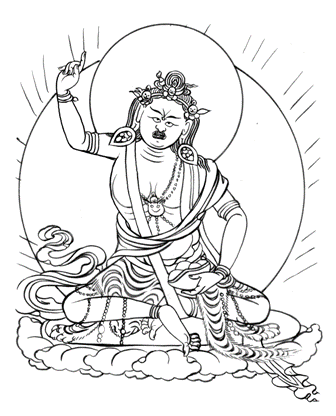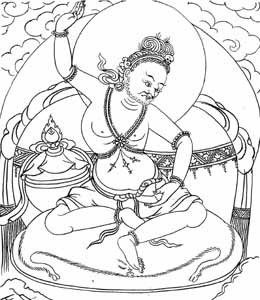Shri Singha: Difference between revisions
Bj Lhundrup (talk | contribs) |
|||
| (6 intermediate revisions by 2 users not shown) | |||
| Line 1: | Line 1: | ||
<noinclude><span class=TibUni16>[[ | [[Image:Shri-Singha.gif|alt Shri Singha|right|400px]] | ||
<noinclude>[[ | <noinclude><span class=TibUni16>[[ཤྲི་སིང་ཧ།]]</span></noinclude><br> | ||
<noinclude>[[shri sing ha]]</noinclude> | |||
===Short Biography=== | ===Short Biography=== | ||
Shri Singha was the chief disciple and successor of [[Manjushrimitra]] in the lineage of the Dzogchen teachings. He was born in the Chinese city of [[Shokyam]] in [[Khotan]] and studied at first with the Chinese masters [[Hatibhala]] and [[Bhelakirti]]. In his ''[[Ocean of Wondrous Sayings]]'', [[Guru Tashi Tobgyal]] adds that Shri Singha received a prophesy from [[Avalokiteshvara]] while traveling to [[Serling]], telling him to go to the [[Sosaling charnel ground]] in order to be sure of the ultimate attainment. After many years Shri Singha met [[Manjushrimitra]] in the charnel ground of Sosaling, and remained with him for twenty-five years. Having transmitted all the oral instructions, the great master Manjushrimitra dissolved his bodily form into a mass of light. When Shri Singha cried out in despair and uttered songs of deep yearning, Manjushrimitra appeared again and bestowed him a tiny casket of precious substance. The casket contained his master's final words, a vital instruction named [[Gomnyam Drugpa]], the [[Six Experiences of Meditation]]. Having received this transmission, Shri Singha reached ultimate confidence. In [[Bodhgaya]] he found the manuscripts of the tantras previously hidden by Manjushrimitra which he took to China where he classified the [[Instruction Section]] into four parts: the outer, inner, secret, and the innermost unexcelled sections. Among Shri Singha's disciples were four outstanding masters: [[Jnanasutra]], [[Vimalamitra]], [[Padmasambhava]] and the Tibetan translator [[Vairotsana]]. [RY] | |||
---- | |||
[ | According to the [[Khandro Nyingthig]] tradition, it is also said that Shri Singha received teachings directly from Manjushrimitra's guru, the [[nirmanakaya]] buddha [[Garab Dorje]]. [[CJD]] | ||
[[Image: | [[Image:ShriSingha.jpg|frame|]] | ||
---- | |||
Additionally, a note by A.W. Barber (see Reference Sources below) says: "I have been able to ascertain that Sri Simha was of central Asian origins and that he lived in India.......Thus, it would appear that Sri Simha took the [[Atiyoga]] line to ''Andhra'' and made his residence at the famous ''Dhanyakataka'' along the ''Krishna River''. From here it was transmitted to teachers who then took the line to Tibet and China." It seems Shri Singha established a permanent residence in South India. | |||
===Literary Works=== | ===Literary Works=== | ||
*[[Fill in the blanks]]<br> | *[[Fill in the blanks]]<br> | ||
===Main Teachers=== | ===Main Teachers=== | ||
*[[ | *[[Haribhala]] | ||
*[[Bhelakirti]] | |||
*[[Garap Dorje]] | |||
*[[Manjushrimitra]] | |||
===Main Students=== | ===Main Students=== | ||
*[[ | *[[Padmasambhava]]<br> | ||
*[[Jnanasutra]]<br> | |||
*[[Vimalamitra]]<br> | |||
*[[Vairotsana]] | |||
===Main Lineages=== | ===Main Lineages=== | ||
| Line 23: | Line 30: | ||
===Alternate Names & Spellings=== | ===Alternate Names & Spellings=== | ||
*[[ | *[[Śrī Siṃha]]<br> | ||
* | *[[Shri Simha]]<br> | ||
* | *[[Sri Simha]]<br> | ||
*[[Shri Singha]]<br> | |||
===Song of Realization=== | |||
The general realization of the Mind Section, the spontaneous meditation song about the precious jewel, was sung in these words by Shri Singha in his meditation hut during a feast offering. | |||
Hung<br> | |||
However thought of, it defies imagination;<br> | |||
However spoken of, it cannot be discerned;<br> | |||
But from the basic space of wakeful vastness<br> | |||
Shines forth a light that never need be sought. | |||
In dharmata which thoughts can never fathom<br> | |||
Remain unwavering and evenly composed.<br> | |||
There is, I see, no other training. | |||
The spear tip of my wakeful knowing<br> | |||
Rends asunder my enemy, my thoughts.<br> | |||
Ratna kosala a hoh | |||
This was the nineteenth; the essential realization of the general Mind Section. ithi.<br> | |||
(from [[Wellsprings of the Great Perfection]]), [[RY]] | |||
===Other Reference Sources=== | ===Other Reference Sources=== | ||
*Dudjom Rinpoche (1991). ''[[The Nyingma School of Tibetan Buddhism]]: Its Fundamentals and History''. Translated by Gyurme Dorje and Matthew Kapstein. Boston: Wisdom Publications. | *Dudjom Rinpoche (1991). ''[[The Nyingma School of Tibetan Buddhism]]: Its Fundamentals and History''. Translated by Gyurme Dorje and Matthew Kapstein. Boston: Wisdom Publications. | ||
*Thondup, Tulku. ''[[Masters of Meditation and Miracles]]''. Boston: Shambhala Publications, 1996. | *Thondup, Tulku. ''[[Masters of Meditation and Miracles]]''. Boston: Shambhala Publications, 1996. | ||
*Nyoshul Khenpo Jamyang Dorjé. ''[[A Marvelous Garland of Rare Gems]]''. Junction City: Padma Publishing, 2005. | *Nyoshul Khenpo Jamyang Dorjé. ''[[A Marvelous Garland of Rare Gems]]''. Junction City: Padma Publishing, 2005. | ||
*[[Wellsprings of the Great Perfection]], Rangjung Yeshe Publications. ISBN 9627341576 | |||
*Padma, Sree. Barber, Anthony W. ''Buddhism in the Krishna River Valley of Andhra''. 2008. pp. 159. | |||
===Internal Links=== | ===Internal Links=== | ||
| Line 43: | Line 67: | ||
===External Links=== | ===External Links=== | ||
*[http://www.tbrc.org ADD TBRC link here] | *[http://www.tbrc.org ADD TBRC link here] | ||
[[Category:Key Terms]] | |||
[[Category:Indian Masters]] | [[Category:Indian Masters]] | ||
[[Category:Buddhist Masters]] | |||
[[Category:Nyingma Masters]] | |||
[[Category:Dzogchen Masters]] | [[Category:Dzogchen Masters]] | ||
[[Category:Early Dzogchen Lineage]] | [[Category:Early Dzogchen Lineage]] | ||
[[Category:Longchen Nyingthig Masters]] | |||
Latest revision as of 08:20, 5 March 2012
Short Biography
Shri Singha was the chief disciple and successor of Manjushrimitra in the lineage of the Dzogchen teachings. He was born in the Chinese city of Shokyam in Khotan and studied at first with the Chinese masters Hatibhala and Bhelakirti. In his Ocean of Wondrous Sayings, Guru Tashi Tobgyal adds that Shri Singha received a prophesy from Avalokiteshvara while traveling to Serling, telling him to go to the Sosaling charnel ground in order to be sure of the ultimate attainment. After many years Shri Singha met Manjushrimitra in the charnel ground of Sosaling, and remained with him for twenty-five years. Having transmitted all the oral instructions, the great master Manjushrimitra dissolved his bodily form into a mass of light. When Shri Singha cried out in despair and uttered songs of deep yearning, Manjushrimitra appeared again and bestowed him a tiny casket of precious substance. The casket contained his master's final words, a vital instruction named Gomnyam Drugpa, the Six Experiences of Meditation. Having received this transmission, Shri Singha reached ultimate confidence. In Bodhgaya he found the manuscripts of the tantras previously hidden by Manjushrimitra which he took to China where he classified the Instruction Section into four parts: the outer, inner, secret, and the innermost unexcelled sections. Among Shri Singha's disciples were four outstanding masters: Jnanasutra, Vimalamitra, Padmasambhava and the Tibetan translator Vairotsana. [RY]
According to the Khandro Nyingthig tradition, it is also said that Shri Singha received teachings directly from Manjushrimitra's guru, the nirmanakaya buddha Garab Dorje. CJD
Additionally, a note by A.W. Barber (see Reference Sources below) says: "I have been able to ascertain that Sri Simha was of central Asian origins and that he lived in India.......Thus, it would appear that Sri Simha took the Atiyoga line to Andhra and made his residence at the famous Dhanyakataka along the Krishna River. From here it was transmitted to teachers who then took the line to Tibet and China." It seems Shri Singha established a permanent residence in South India.
Literary Works
Main Teachers
Main Students
Main Lineages
Alternate Names & Spellings
Song of Realization
The general realization of the Mind Section, the spontaneous meditation song about the precious jewel, was sung in these words by Shri Singha in his meditation hut during a feast offering.
Hung
However thought of, it defies imagination;
However spoken of, it cannot be discerned;
But from the basic space of wakeful vastness
Shines forth a light that never need be sought.
In dharmata which thoughts can never fathom
Remain unwavering and evenly composed.
There is, I see, no other training.
The spear tip of my wakeful knowing
Rends asunder my enemy, my thoughts.
Ratna kosala a hoh
This was the nineteenth; the essential realization of the general Mind Section. ithi.
(from Wellsprings of the Great Perfection), RY
Other Reference Sources
- Dudjom Rinpoche (1991). The Nyingma School of Tibetan Buddhism: Its Fundamentals and History. Translated by Gyurme Dorje and Matthew Kapstein. Boston: Wisdom Publications.
- Thondup, Tulku. Masters of Meditation and Miracles. Boston: Shambhala Publications, 1996.
- Nyoshul Khenpo Jamyang Dorjé. A Marvelous Garland of Rare Gems. Junction City: Padma Publishing, 2005.
- Wellsprings of the Great Perfection, Rangjung Yeshe Publications. ISBN 9627341576
- Padma, Sree. Barber, Anthony W. Buddhism in the Krishna River Valley of Andhra. 2008. pp. 159.
Internal Links
- One of the Twenty-One Indian Panditas (rgya gar gyi mkhas pa nyi shu rtsa gcig) [RY]

